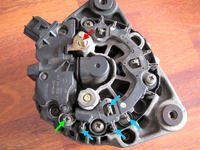Hello, I'm specifically talking about how to check the alternator removed from the car
and I do not mean a visual check, because the brushes can be removed and
check their condition rings as well as strong puncture on the rotor
or standing also an ordinary meter, but I know that it does a special one
cable combinations together with the excitation bulb and this connects to the alternator
together with the battery and the drill drives, if it is ok, the drill decreases
rotation and the bulb goes out. Please send me this combination diagram
these cables and connecting them to the alternator, best regards GREG if anyone
would know links to such pages with descriptions, please share them with me.

and I do not mean a visual check, because the brushes can be removed and
check their condition rings as well as strong puncture on the rotor
or standing also an ordinary meter, but I know that it does a special one
cable combinations together with the excitation bulb and this connects to the alternator
together with the battery and the drill drives, if it is ok, the drill decreases
rotation and the bulb goes out. Please send me this combination diagram
these cables and connecting them to the alternator, best regards GREG if anyone
would know links to such pages with descriptions, please share them with me.



